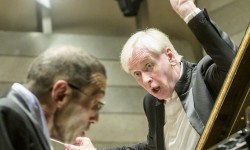C. Saint-Saëns. Piano Concerto No. 2 in G minor, Op. 22 D. Shostakovich. Symphony No. 15 in A major, Op. 141
***
The talent and charisma of the fiery piano virtuoso Alexander Paley does not leave any member of the audience indifferent. The artist, who lives between New York and Paris, is welcomed in concert halls around the world, but always finds time to return to Lithuania. “I adore maestro Gintaras Rinkevičius. Throughout my career, I've played with a variety of conductors and orchestras, but I have to admit that playing with this Maestro is simply the best feeling", – says the famous pianist. Already in 1991 after the pianist's debut with the US National Symphony Orchestra, the newspaper "The Washington Post" called A. Paley's performance "simply flawless", and thus, eventually the pianist began to perform with the world's most famous orchestras. The audience gave him standing ovations, and critics heaped praise on him for his "dazzling technical prowess", "compelling performance", "personal interpretations" and "incredibly wide repertoire". Over the years, A. Paley's star has not faded – the pianist performs roughly 80 concerts around the world every year. Tonight, A. Paley will perform Camille Saint-Saëns (1835-1921) Piano Concerto No. 2. Written in just three weeks in 1868, the piece remains to this day as composer's most popular piano concerto, characterized by an unexpected variety of styles. "It begins with Bach and ends with Offenbach," – quipped Zygmunt Stojowski, a prominent Polish pianist and composer of the time.
During the second part of the concert, the Lithuanian State Symphony Orchestra, conducted by the artistic director and chief conductor Gintaras Rinkevičius, will continue the series of symphonies by Dmitri Shostakovich (1906-1975) and will perform the composer's last, Symphony No. 15. Written in just one month in the summer and autumn of 1971 at the Composers' Creative House in Repin, the Fifteenth bursts with splashes of unexpected contrasts. According to musicologist Viktoros Gerulaitis, in the symphony the composer combines tragedy with fun, deep reflections with murderous jokes in a Shakespearean manner. The form of the symphony is classically proportional, clear, balanced, but the meaning of the music is encrypted. Composer Rodion Shchedrin said about the symphony: "The grandiose Fifteenth is one of the peaks of his work, a peak from the "8000" level, as mountaineers would say. D. Shostakovich has an enviable gift to feel, perceive the work as a whole organism, and not a chain of necklaces, connected or not connected between episodes and thematic formations. In addition, he is a great master of "beginnings" and "endings" of works. The finale is followed by a kind of post scriptum with hypnotic fading bars around the sound A. The meaning of such an ending is ambiguous, philosophical. You can't put it into words."




